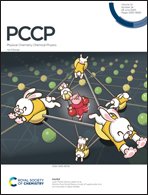Efficient prediction of nucleus independent chemical shifts for polycyclic aromatic hydrocarbons†
Abstract
Nuclear Magnetic Resonance (NMR) is one of the most powerful experimental techniques to characterize the structure of molecules and confined liquids. Nevertheless, the complexity of the systems under investigation usually requires complementary computational studies to interpret the NMR results. In this work we focus on polycyclic aromatic hydrocarbons (PAHs), an important class of organic molecules which have been commonly used as simple analogues for the spectroscopic properties of more complex systems, such as porous disordered carbons. We use Density Functional Theory (DFT) to calculate 13C chemical shifts and Nucleus Independent Chemical Shifts (NICS) for 34 PAHs. The results show a clear molecular size dependence of the two quantities, as well as the convergence of the 13C NMR shifts towards the values observed for graphene. We then present two computationally cheap models for the prediction of NICS in simple PAHs. We show that while a simple dipolar model fails to produce accurate values, a perturbative tight-binding approach can be successfully applied for the prediction of NICS in this series of molecules, including some non-planar ones containing 5- and 7-membered rings. This model, one to two orders of magnitude faster than DFT calculations, is very promising and can be further refined in order to study more complex systems.



 Please wait while we load your content...
Please wait while we load your content...